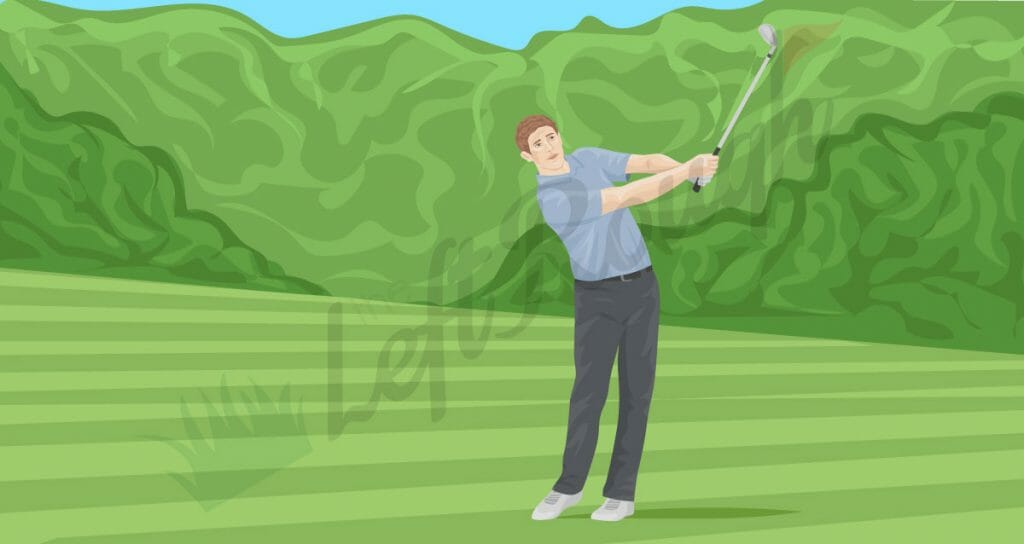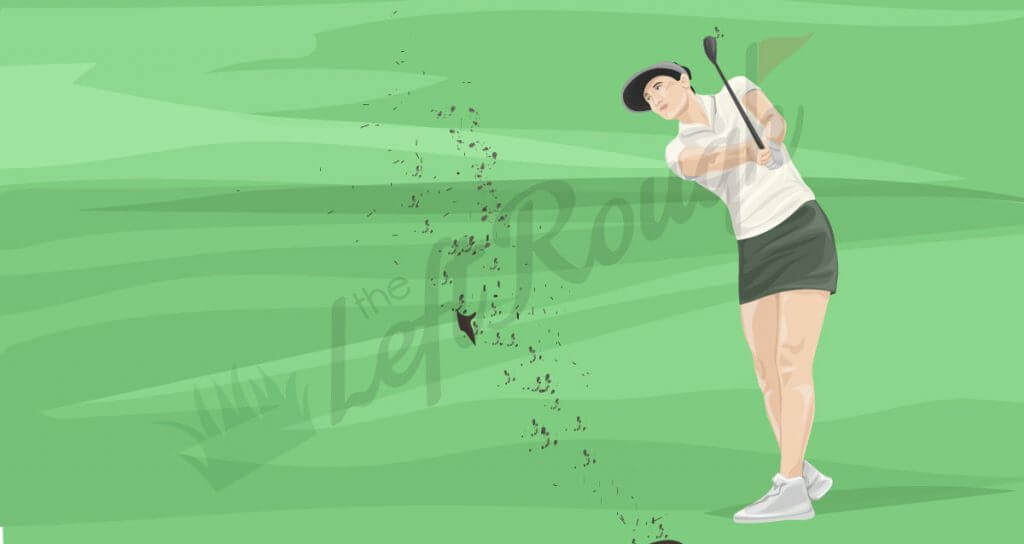
Do you want to learn how to flight wedges like a pro that hits, bounces, and stops on the greens? If so, you’re in the right place.
Hitting flighted wedges is a lot easier than you might think and a great shot to have in your bag. If you watch golf on TV, you’ll notice that pros hit these types of shots often and make it look easy.
When you read this article and practice the tips provided, you can flight wedges too – even as an amateur golfer.
How to Flight Wedges
Flighted wedges are a type of knockdown shot where the ball travels at a lower trajectory than normal. A lower ball flight produces less backspin, which makes the ball hit, skip, and stop instead of spinning backward.
Fighting wedges is a great idea when hitting into a back pin position to avoid going long and short siding yourself. This shot is also ideal for playing in the wind.
With a few adjustments to your setup, you can hit these consistently and hopefully improve your scoring averages.
Key Takeaways
- Flighted wedges are when you hit a wedge at a lower trajectory than normal, similar to a knockdown shot.
- A flighted wedge will travel less distance than normal at a lower trajectory with less spin.
- When you flight wedges, the goal is to have the shot hit the green and stop, not produce backspin.
- With a few setup tweaks, it’s easy to hit flight wedges and improve your game inside 125 yards.
Keep reading to learn what clubs work best for these shots and how to hit them consistently.


Use the Right Wedge
Technically, you can flight wedges with any wedge in the bag. However, most golfers will find that flighting wedges is a lot easier with a sand or gap wedge vs. a lob wedge.
Why? Loft…
More loft simply makes it more challenging to flight the shot.
Not to mention, lob wedges are one of the more difficult clubs to hit for mid to higher handicap golfers. If you haven’t tried these shots out before, I suggest starting with a gap wedge (also known as an approach wedge). Once you get the hang of it, try this shot with an SW or LW.
You will also typically need to club up as the shot won’t travel as far as a normal wedge. For example, I hit a full gap wedge 125 yards but if I’m hitting a knockdown shot, I’ll plan for it to go about 10 yards less (115 yards).
Wondering how far you should hit your wedges? Read this guide to learn more now.
Play the Right Wedges for Your Game
One last thing before getting into the instructions to hit flight wedges… make sure you’re playing the right wedges for your swing.
I tend to see a lot of mid to high handicap golfers using lightweight graphite shaft irons with cavity backs for increased forgiveness – which is a great idea. These clubs make mishits a lot better and ideal for average swing speeds.
However, a lot of times these same players then use wedges that are meant for lower handicap golfers, like a Titleist Vokey. It’s very important to make sure your wedges are similar to your irons so you have enough forgiveness.
Make sure to read our guide for the best wedges for high handicappers here.


Adjust Your Setup
Once you have the right wedge for the shot, the first thing you want to do is adjust your setup position.
Start by taking a more narrow stance so it’s easier to make a shorter backswing. You do not want or need a full backswing to hit flighted wedges. This type of shot requires a ¾ backswing and ¾ follow through.
Next, choke up on the grip one inch, so the club is easier to control and also help promote a shorter backswing. As mentioned in a Golf.com article, “The main benefit here is you’re better able to control the club by shortening your swing, which is key.
A shorter swing produces less ball spin, and that helps you keep the ball straighter and lower. Choking down combined with a middle-back ball position also promotes more solid contact.”
The final part of the setup to change is ball position.
Move the ball one inch back in your stance so it’s middle or just behind the middle of your stance. A good reference point is just to the right of the buttons on your shirt (assuming you’re a right-handed golfer).
Don’t Sway
A narrower stance should help you swing with a more controlled swing. Remember, you don’t want to try and hit this wedge shot 100% of its normal distance. Instead, you want a simple controlled swing.
A stance with less width can help you stay centered over the ball during your swing.
One of the biggest problems that golfers make is swaying, usually to generate power. But as mentioned, we don’t need a ton of speed or power for this type of shot.
To help reduce swaying, favor more weight on your lead leg.
You can also drop your trail foot back slightly to help get more weight on your front leg which will make it easier to transfer your weight properly.
Having more weight on your lead leg will also help you produce a steeper downswing. This will help the ball flight at a lower trajectory which is the foundation of flighted wedges.


Dial in Your Tempo
Whether you’re hitting a drive, iron, flighted wedge, or putt, tempo is so important.
One of the best ways to make sure your tempo is dialed in is the Tour Tempo app. This app makes it easy to practice tempo by using the interactive tones to help sequence your swing properly.
What’s great is they have a part of the app for long game tempo (which is 3:1 timing) and short game tempo (which is 2:1 timing). Whether you’re learning to hit flighted wedges or want to work on your greenside bunker game – or any short game shot – this app makes it easy.
Having the right tempo will ensure you accelerate properly while still having plenty of speed through the shot.
Don’t Skip Your Pre-Shot Routine
Whether you’re hitting a full wedge, flighted wedge, or basic chip shot, a routine is key to getting your mind ready for the shot. If you watch your favorite golfers on TV, you’ll notice they all have a consistent routine on every type of shot.
A pre-shot process helps with:
- Analyzing the lie and type of shot.
- Picking the right wedge and distance for the upcoming shot.
- Making proper practice swings to get your mind/body ready for the shot.
Click here to learn more about creating a pre-shot routine.
Practice Flighted Wedges on the Range
The last tip to help you hit knockdown wedges is to make sure you practice on the range before trying to take to the course.
With any shot – whether it’s a stinger or recovery shot – you never want to try it out for the first time on the golf course. Always practice it on the driving range so you can have confidence on the course.
I always encourage golfers to have specific practice sessions that focus on inside 125 yards. To me this is the “scoring zone” and crucial to getting the most out of your game.
After you’re warmed up, hit different flighted wedges with each wedge. Notate how far each one goes with the help of a personal launch monitor to build a wedge matrix.
Remember, every golfer should have two distances with a wedge – a full swing and knockdown type of shot.
FAQs About Wedges
Do you have more questions about wedges to take your short game to new heights? If so, keep reading through the most frequently asked questions now.
What does a flighted wedge mean?
A flighted wedge refers to a shot that is a lower trajectory than normal.
These shots typically have a lower launch and slightly less spin. The goal is to help the ball hit the green and stop… not spin backward which is very hard to judge (especially if you’re playing soft greens).
How do you control the trajectory of wedges?
To control the trajectory of wedges, you want to first choke up on the golf club. Making the club shorter makes it easier to take a smaller, more controlled swing which is needed for a lower trajectory. You’ll also want a shorter backswing and abbreviated follow through too.
How do you hit wedges properly?
Wedges are some of the easiest clubs to hit properly because they have a lot of loft (45–64 degrees) and are shorter than irons. The shorter a club is, the easier it is to hit consistently well and usually has a much tighter shot dispersion.
To hit a wedge properly, you want to:
- Push your hands slightly ahead at address.
- Have the ball position in the middle of your stance.
- Take a slightly more narrow stance than when hitting irons.
- Take a more controlled backswing (you don’t need a super long backswing).
Lastly, make sure to always accelerate through the shot.
How do pros hit the wedges so far?
Professional golfers hit wedges and all clubs so far because they have incredible fundamentals. They’re able to hit the sweet spot a lot more often and have plenty of swing speed too.
With wedges specifically, they hit them so far because they have a lot of forward shaft lean at impact position. This means the grip of the club is ahead of the face, which results in a compressed golf shot.


Can you flight short irons?
Yes, you can flight short irons using the same steps as above. I like to have a full short iron distance and knockdown distance when playing in the wind or hitting to different pin locations.
My Experience
Learning to flight wedges is key if your goal is to start breaking 80 or become a scratch golfer. After tracking my stats in the 2023 season, it became evident that my game needed help from 50 to 100 yards.
After talking with a top short game coach, it became evident I needed to have a wedge distance chart. In the offseason, I’ve spent a ton of time in the simulator and driving range, working hard on this area.
My goal was to develop a wedge matrix, so I have four distances with my LW and SW. And have three distances with my GW & PW. Please note – I’m a plus handicap and not something you need to do if you’re a casual golfer.
However, if you’re serious about improving your game, creating a wedge matrix can have a massive impact on your scoring. Now, I have different distances based on my backswing length.
For example, if I take my LW back to my rib cage and follow through the same length, it’s a 65-yard carry. If I take it back to my shoulder, it’s closer to 77 yards.
This gives me a lot more confidence on the golf course when I’m inside 100 yards and need a partial swing wedge distance. Relying less on feel and instead specific positions (some people like the clock method) has given me a lot more consistency in my wedge game.
Final Thoughts
Spend more time working on your wedges if you want to improve your game and lower your handicap. Learning to hit wedges is a lot easier than longer clubs and can usually lead to better scores fast.
Aside from learning to hit flighted wedges, make sure to read these short game articles as well.







